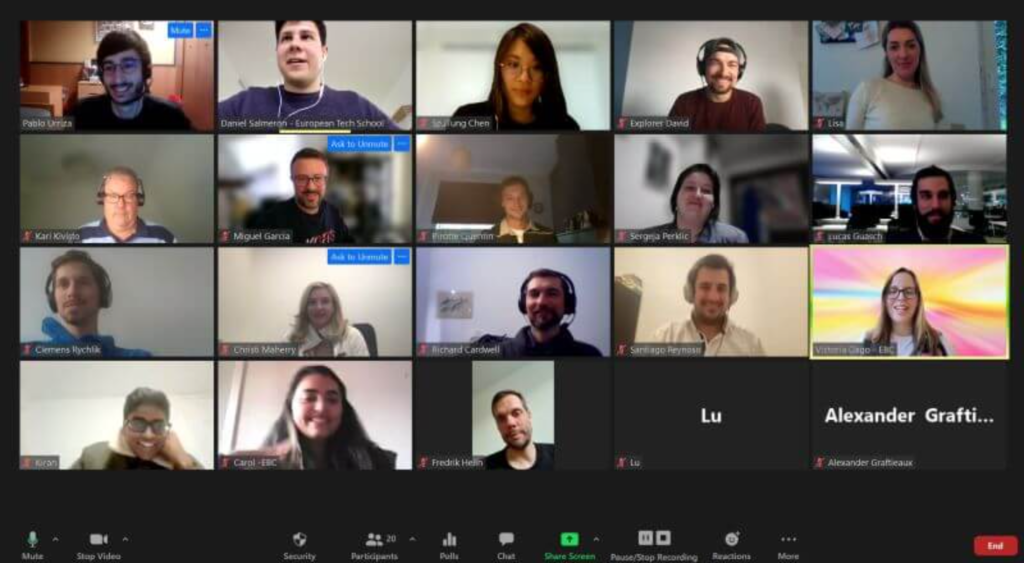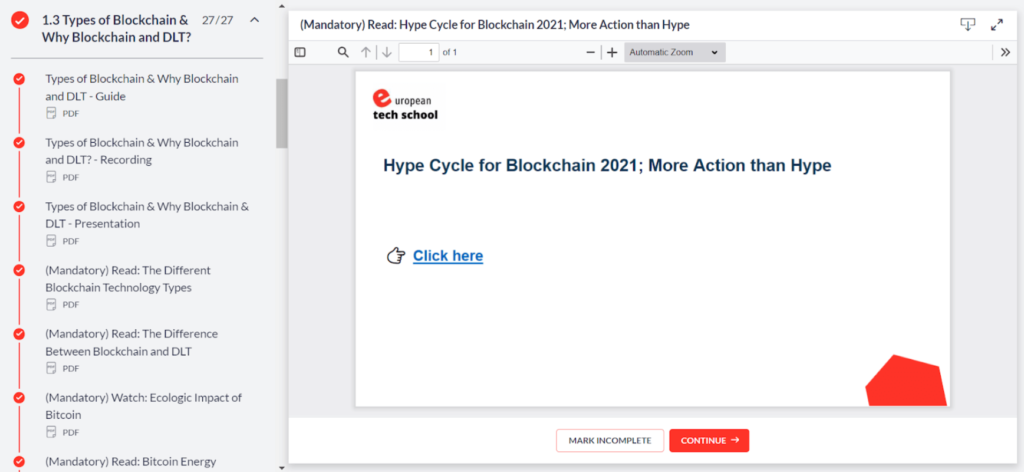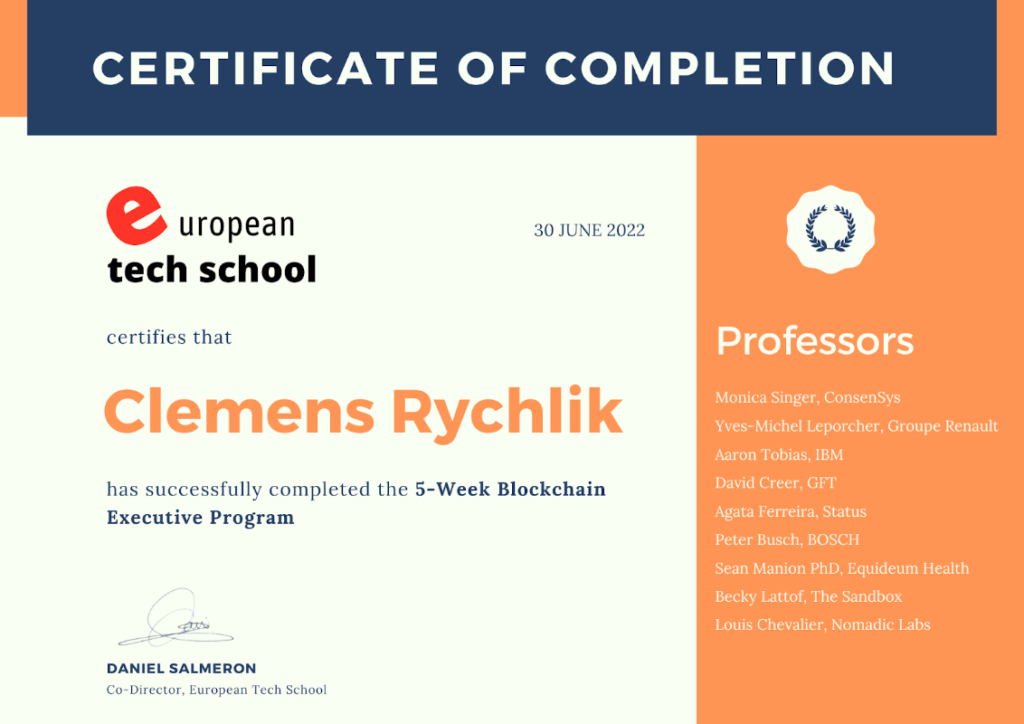Blockchain is omnipresent. Whether it’s because a stablecoin crashes (like TerraUSD), another NFT sells for a record amount, or a new blockchain project gets announced – the media are all over it. This is especially true whenever crypto prices enter a freefall or start a bullish rally. So amidst all the hype and excitement, why not try to find out what’s behind it? That’s precisely what I did by enrolling in European Tech School’s Blockchain Executive program.
And in this post, I reflect on my expectations and experience by sharing my honest, no-filter opinion.
What is the Blockchain Executive Program?
First things first: The Blockchain Executive Program at European Tech School (ETS) is a 6-week course consisting of live classes, self-paced materials, and assignments. The first five weeks feature 3x 2-hour classes per week – usually starting at 18.30 on Tue, Wed & Thu – led by experienced professionals in their respective fields. The last week is fully dedicated to working on the final coursework. Upon completion, participants receive a certificate.
Sidenote: There is also a longer, 12-week “Blockchain Expert” program that goes even more in-depth.
Why even bother taking a blockchain course?
I have a busy full-time job working for both Barcinno and Bourbon Creative, I’m currently learning Italian, and I work out regularly – when the first week of the course took place, I was actually in my last days of preparation for the Barcelona half-marathon. So why did I want to add a time-intensive blockchain course on top of that?
Well, I do enjoy learning, and I’m curious. And blockchain seems to be literally everywhere and talked about all the time. Also, I like to live by the proverb: “When two paths open before you, take the harder one.” So instead of continuing my weekly routine as it was, I opted for a challenge.
What I hoped to get out of it were three things. To be able to:
- Find out if blockchain is really a big thing that will change society as we know it
- Separate hope from hype when it comes to blockchain use cases and projects
- Understand how it really works and where the true value comes from (and so I can stop watching yet another Youtube video in an attempt to understand blockchain)
Did the course meet my expectations? Read on!
So what’s it like to do the ETS blockchain course?
The first day felt like going back in time, back to school
“Hi, my name is Clemens. Want to be my friend?”. Well, I made up the last part, but the first week definitely felt like being back in secondary school. All the introductions by students and teachers evoked a bit of nostalgia.
The other thing that jumped out immediately amidst the meet-and-greet bonanza was the high level of diversity – in every single possible way. My cohort consisted of approximately 20 people and featured a great variety of:
- Cultures: from Finland over India to the USA
- Backgrounds: pharma industry professionals, marketers, crypto investors, successful entrepreneurs, and even a guy working at a refinery
- Motivations: blockchain skeptics, fanatics, and even experts who have already begun working on their own blockchain projects
- Ages: from young students that are still in school to retired business owners
- Genders: not quite 50-50, but close to it
On another note, the tech set-up was pretty straightforward and intuitive. The course featured a learning platform based on Thinkific which included everything we needed: an overview and schedule of the course and units and access to all learning materials and slides for each class. The live classes were delivered by professors via group Zoom calls, with the built-in chat and raise-hand feature being particularly handy for allowing every student to ask questions. Additionally, each session was recorded and uploaded on the learning platform, so you could rewatch it if you missed a class or simply wanted to go over a particular section again.
An underestimated but great advantage: the ETS Slack group. Having access to the Slack group helped me to connect with students from the current and past cohorts. It also enhanced knowledge sharing, such as asking for advice, exchanging thoughts on the latest news, and even discussing job opportunities.
Blockchain 101: Introductory classes progress at the right pace
Following a quick kick-off class, the course started on a relatively “lighter” note, focusing on blockchain fundamentals and the big picture. This was achieved via two elementary lectures – which still went in-depth and became quite technical at the end – titled Introduction to Bitcoin and Blockchain and How Blockchain Works & Blockchain Applications.
During this step, and the rest of the course, one of the biggest value-adds to my learning was the opportunity to ask “stupid” questions – and for the professors to patiently answer them in a clear, non-techie way. This was really helpful in understanding the basics. The teachers also provided me with useful links to material that allowed for further self-studying after the class.
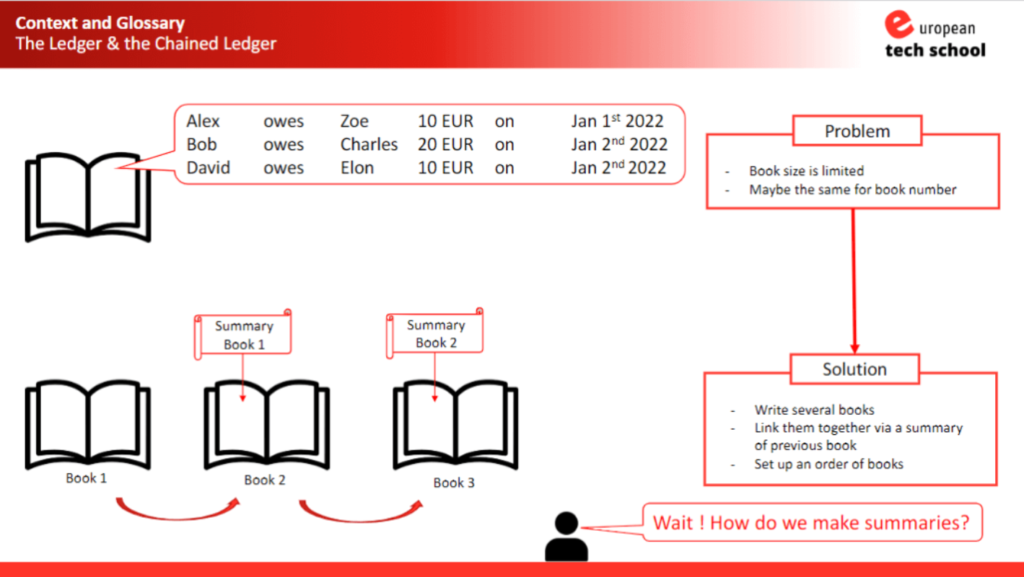
Both introductory lectures fulfilled my hopes to finally understand the foundation of blockchain. Did I become an expert? No, but I’d say my knowledge and understanding of the basics went up from maybe 5-10% to 90-95%. Terms like hashes, nodes, and mining now make more sense to me. So while I perhaps still don’t get all the technical details at the deepest level, I certainly grasp the fundamentals. This provided me with a solid basis for the next stage of classes which were definitely increasing in complexity.
What became clear, though, is that I needed to dedicate more time to really go in-depth and understand the essence of blockchain. Two 2-hour classes and some readings won’t cut it, especially with the industry and technology evolving so rapidly.
There are no shortcuts: if you want to learn fast, you need to invest time
Right off the bat, I was amazed by the sheer volume of helpful learning materials shared on the platform. Some units required reading or watching more than a dozen content pieces. And even though not all of these were mandatory, the more time you invest, the better your learning experience. Additionally, we got some individual or group homework to work on every other week.
So to get the most out of the course – e.g. be able to ask more advanced questions in the classes – you need to make a significant time commitment to go through all the self-paced materials. This is especially true in the first weeks, where each class helps you better understand the next one as the complexity level progresses. For instance, good luck analysing a White Paper on Polkadot without having yet learned and processed the fundamentals of blockchain.
In my case, I even had to take a half-day off in week two to catch up with all the coursework. Though I have to add this was due to multiple external factors coming together to create the perfect storm: running a race I only practised 10 weeks for, a personal emergency requiring me to fly out to Poland and back home to Barcelona within 24h, and inevitably catching COVID on that journey. And even when finalising this article – a month after my course officially finished – I’m still not done going through all the reading materials. This is actually intended, however, as many professors add so many materials before, during and after class that you can decide on which topics to deep-dive into.
Moving from basics to the real world: use cases start blowing your mind
The real fun begins once you grind through all the blockchain basics, technicalities and types. A wild potpourri of use cases was covered: from Decentralised Finance (DeFi), health care and supply chain to NFTs, Self-Sovereign Identities (SSI) and IoT.
My personal favourites: DeFi, SSI and IoT.
DeFi will transform our society sooner or later (probably later)
Coming from a finance background, DeFi is, despite the recent crash of the Terra / Luna project, one of the most fascinating use cases for me. Virtually, for any traditional financial service you can think of, there is already a blockchain equivalent (see image below). That’s kind of mind-blowing. The most fascinating thing is the potential for DeFi to democratise finance by making it available to the people who currently have no access to banking services. Of course, a lot of regulatory questions need to be asked and resolved and transaction cost is, in most cases, still fairly high when dealing with lower amounts. But DeFi, in my humble opinion, will transform our society eventually.
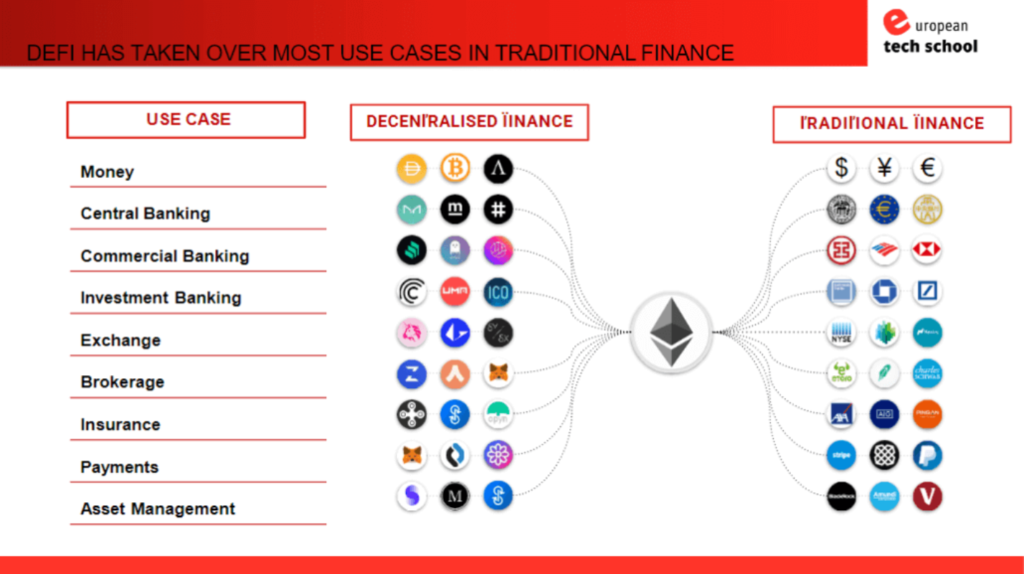
SSI: the ownership and management of personal data we always dreamed of
I have to admit that the field of SSI has been completely off my radar and I had little to no knowledge in that field before starting this course. Yet, what I quickly realised during the class on this subject is that it’s one of the most enticing blockchain use cases. With all the privacy issues in the digital world (e.g. the Cambridge Analytica & Facebook scandal), it’s absolutely essential that we find solutions that allow us to own our personal data, control how it’s used, and get compensated for when it’s with third-parties. Moreover, we need digital identification and verification to be seamless and based on the minimum disclosure principle. That’s exactly what SSI can solve. Check out the following video from IBM about a blockchain-based employment credential system for a glimpse of how this can look in real life.
IoT devices that speak and make transactions between each other
Finally, using blockchain technology in the IoT ecosystem is one of the most fun and exciting use cases. Just imagine a world where your car, fridge or even screwdriver can not only communicate between each other and external devices but also execute transactions for you. For instance, you’re heading to your favourite restaurant for a date at 9 pm. You’re a bit late, so you ask your car to secure and guide you to the nearest parking spot. The car then immediately scans all the available parking slots – including those offered by private individuals on a decentralised marketplace – negotiates the price, and pays for the best space based on your personal preferences. Moonshot? Well, as the video below shows, organisations are already working on this (find more info on this use case here).
The “dark side”: regulations & blockchain in the corporate world
While not the most exciting subject for many, the concluding course on the regulatory landscape relating to blockchain is essential. It doesn’t aim to give you full details on a specific regulation but rather shows what the legal situation looks like and where it may go next. My takeaway is that, at the moment, the legal frameworks regarding blockchain and cryptocurrency projects are pretty much a Wild West.
Most lawmakers are struggling to understand the core functionalities before even being able to come up with suitable regulations. And even if they manage to regulate one aspect, they’re still constantly playing catch up as the industry evolves so quickly. For example, while many governments still struggle to come to grips with cryptocurrencies or stablecoins, we now already have sophisticated DeFi projects and Decentralised Autonomous Organisations.
So despite the EU expecting to roll out a Markets in Crypto-asset (MiCa) regulation soon, there is still much work ahead. And regulation itself can be a good or bad thing, depending on the approach governments take. The biggest danger here is policymakers succumbing to lobbying by those who feel most threatened by the blockchain, crypto and web3 industry – banks, big tech firms, and other powerful organisations that currently benefit from centralised solutions. If they do, their countries will fall behind in the tech race.
The other interesting learning for me was understanding the complexity and limitations of smart contracts. Since these trigger automated actions, their clauses must be specific and clear. However, some legal terms (i.e. “in good faith”, “to the party’s best effort”, etc.) simply can’t be put into a smart contract.
Would I recommend the ETS Blockchain Executive Program?
Absolutely! Is it for everyone? Not necessarily. Let me explain:
Pros
- Knowledgeable professors: All professors are fantastic and experts in their respective fields. They’re capable not only of teaching but also of sharing real-life experiences and use cases.
- Unbiased views: Generally, there was a surprisingly realistic, unbiased view of blockchain’s potential. Yes, some professors were more encouraged and excited by it than others, but there were no fanatics ignoring any downsides or selling it as the holy grail solution to all of the world’s problems. Legitimate concerns and limitations about the technology are addressed. Some are disproved based on facts, but others are also pointed out as valid counterpoints.
- Supportive Slack community: An underestimated perk of the course is the access to a dedicated Slack channel. This is a place where you not only get updates about the course and the chance to connect with your cohort, but it’s also where you form part of the entire alumni group. So it’s the perfect place to share questions, tips and interesting reads. For instance, after multiple professors recommended we move our crypto investments into private wallets, I asked for suggestions on what cold or hot wallet to get and got tons of great replies.
- Interactive learning: Biggest plus: being able to ask experts in the field any type of question. Even “stupid” ones. This really accelerates the learning curve. The teachers were also great at pointing you in the right direction for additional reading. And all were generally open to answering any further questions outside the classroom.
- A wide network: The program gives you the chance to connect with leading experts – whether it’s professors, current students or alumni – in the field which you might otherwise have a hard time reaching or building up in such a short time. For example, in my work at the marketing agency Bourbon Creative, I was able to get and use a quote from one of our teachers in an article we wrote for a client. I’ve also jumped on calls with fellow students who run their own blockchain projects to get better insights into blockchain marketing best practices.
- Certificate: While I don’t like bragging, I am a marketer, so I do understand the value a certificate brings in terms of showcasing your expertise. So whether you want to pursue a career in blockchain, raise funds for your blockchain project, or grow your blockchain client base, this is a very useful tool to prove your knowledge in that field.
Cons
- Very time-intensive: With 6h of live classes per week plus at least another 6h (in my experience) to do mandatory reading, homework and self-studying, you need to plan and dedicate your time wisely. Especially if you want to make it work on top of a full-time job.
- Not all units are equally interesting: Depending on your background and goals, some units can be less exciting than others. E.g. coming from a business and finance background, I was mostly interested in DeFi and other use cases from the real world, while I was less into the “Metaverse”/sandbox class – which has nothing to do with the professor, by the way.
In short, if you have enough time or can carve out sufficient weekly hours, the program is absolutely worth it. If you’re already struggling with juggling your existing workload, family time and social life, be aware that you’ll most likely need to make sacrifices or postpone starting the course until you have more time. In my opinion, you get the most value out of the course if you have at least half a dozen hours available each week to go through all reading materials, do homework and self-study. This helps you get the full benefits of the live classes, especially in terms of asking smart questions and, ultimately, accelerating your learning curve.
What did I actually learn? Stay tuned for my follow-up article where I share my thoughts and predictions on all things blockchain.
If you want to discuss my experience in more detail, feel free to reach out to me on Linkedin.
To sign up for the European Tech School’s Blockchain Course or find out more, click here – and bag a 25% discount by using the exclusive Barcinno code: ETSBARCINNO.

